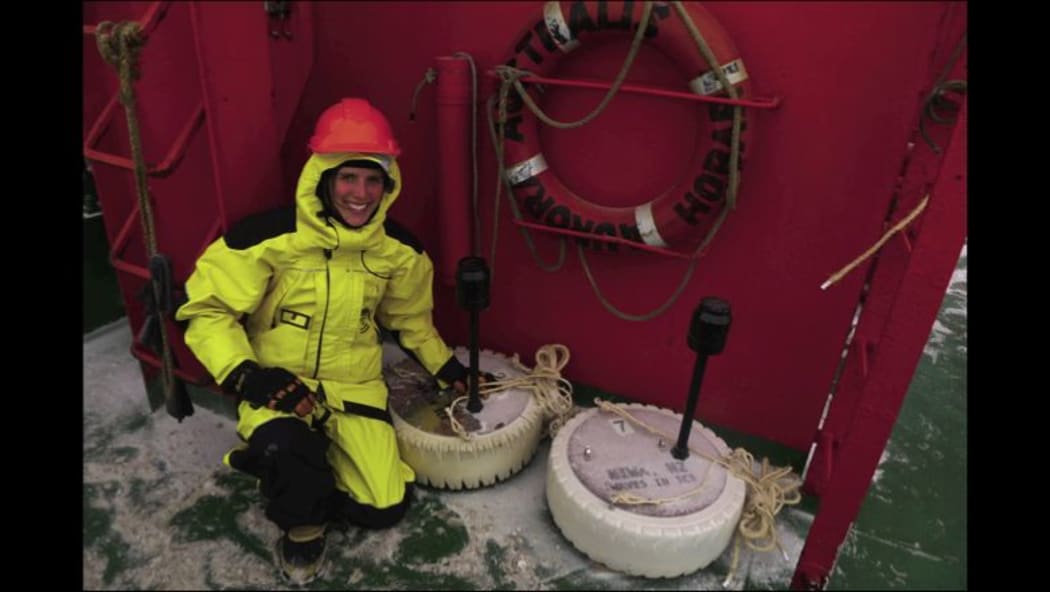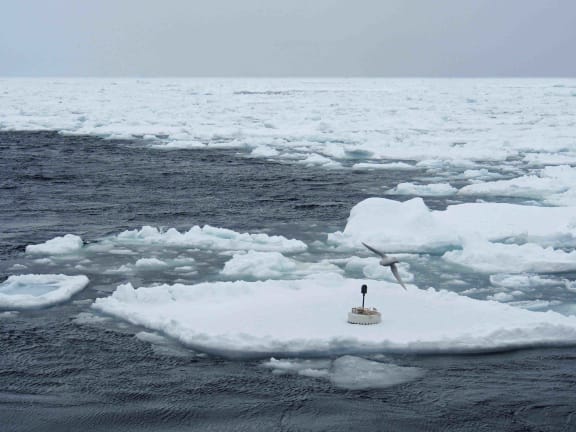by Veronika Meduna Veronika.Meduna@radionz.co.nz

New Zealand Icefest, in Cathedral Square in central Christchurch, continues to 12 October. Photo: RNZ / Veronika Meduna
This week marks the start of the Antarctic research season and the opening of New Zealand Icefest, a two-week festival celebrating all things Antarctic in Christchurch. The programme includes exhibitions, including Antarctic Time Travel, which takes visitors on a journey through different Antarctic climates from 50 million years ago to the present, a film festival, holiday activities and discussions about Antarctic heritage, history, culture, arts, politics and science.

At the opening of New Zealand Icefest, sledge dogs pulled a tram to the festival hub in central Christchurch, where June Lady Hillary broke the ice. On the right, children explore the comfort of polar tents. Photo: RNZ / Veronika Meduna; Jeanine Begg
Antarctica's Frozen Ocean
Each autumn, the ocean around Antarctica freezes and forms an apron of sea ice around the entire continent. When the sun returns in spring, the sea ice is largely broken up again in an annual event that counts as the world's largest seasonal change.

Alex Gough was part of a team that wintered over at Scott Base to gather the first year-round observations of sea ice formation and thickness in McMurdo Sound. Photo: Andy Mahoney
One of the discussions at New Zealand Icefest focused on sea ice and the puzzling phenomenon of an increasing sea ice extent in the Southern Ocean. University of Otago physicist Pat Langhorne told the audience that sea ice has many roles in Antarctica's ecology and climate, in particular the continent's albedo, or reflective effect.
'It forms in the winter because the air temperatures are cold and it doubles the whiteness that you would see if you were up in a satellite. And this is very important for how much of the sun's energy gets into the ocean, because the white surface will reflect a lot more of the energy back up to the sky than if you had a dark ocean around the continent.'
Pat Langhorne's research focuses on crystals that form within Antarctic sea ice, in particular platelet ice that forms on the underside of sea ice in areas close to large ice shelves. She measures the size and orientation of the crystals in ice cores drilled out of the sea ice, which can help determine the conditions under which the ice formed.
You can listen to our earlier interviews with Pat Langhorne and her team, which became the first to winter over at Scott Base to monitor sea ice growth during the polar night.

NIWA scientist Alison Kohout with two of the wave sensors, ready to be deployed onto the ice. Photo: Rosemary Croasdale
'There's this rather interesting phenomenon in Antarctica, and that's that sea ice is increasing. This is a big question for Antarctic science and also climate science.' - Alison Kohout, NIWA

A buoy to measure waves in the Southern Ocean is lowered on to sea ice from the research vessel Aurora Australis. Photo: Wendy Pyper
Hydrodynamics scientist Alison Kohout, at the National Institute of Water and Atmospheric Research, says there is regional variability in the extent of sea ice around Antarctica, but overall the area of sea ice has been increasing. She says natural variability could be one explanation, but another ideas are that changes in atmospheric pressure and therefore in wind patterns in Antarctica are driving regional changes in sea ice growth, or that the melting of ice shelves contributes more freshwater to the ocean around the continent.
Earlier this year, Alison was part of a team of New Zealand and Australian scientists who published research that shows that storms at the edge of the Antarctic sea ice zone can send large ice-breaking waves hundreds of kilometres into the pack ice. She says the interaction between sea ice and waves is currently not captured by climate models, but the team found a strong correlation between the regional variability in sea ice extent and wave height. Increasing storminess in the Southern Ocean could accelerate sea ice retreat in the future, she says, with implications for sea ice processes and marine creatures.
Many other aspects of Antarctic science will be explored during New Zealand Icefest, which continues until 12 October, and you can also find many interviews in our Antarctic collection.

